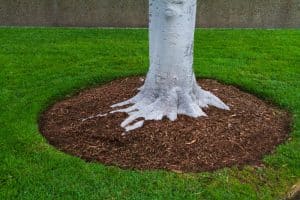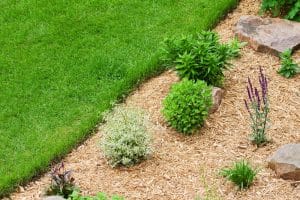Wood chip mulching is a popular choice for Aussie gardeners. It offers a plethora of benefits, from suppressing weeds and retaining moisture to regulating soil temperature and improving aesthetics—a beauty, right? But is simply dumping a pile of wood chips around your plants the best approach? Sorry, but the answer is a resounding no! There are techniques used in this work that significantly impact its effectiveness and the health of your garden.
To delve deep into this topic, first, remember the basics for it will give you a huge impact and understanding in this topic.
Does wood chip mulching require special techniques?
Yes! It does. However, many first-time gardeners assume this is a straightforward task – just spread the chips and walk away. But, no mate, there are proper techniques that are crucial to harvest the full benefits if it and avoid potential downsides.
Should you use fresh or aged pulpwood for mulching?
If you want to be sustainable and don’t want to harm your plants, you need to know the fundamentals. The two types of lumber pulp you use also play a role in technique.
- Fresh shreds: They’re readily available and often cheaper. However, fresh ones contain high levels of carbon and can rob nitrogen from the soil as they decompose. This can harm your plants if not addressed.
- Aged chips (composted): These shredded boys have already begun decomposing, reducing the risk of nitrogen depletion. They also tend to be more uniform in size and provide better drainage. However, they might be more expensive and less readily available.
Moreover, you also need to know the factors once you select your chips. Here’s what you need to know:
- Unaged: If opting for fresh and budget-friendly, use a larger size (around 5cm) to slow down decomposition and allow more time for nitrogen supplementation. Ensure that they are seasoned for at least 3-6 months before applying them around your plants.
- Old and seasoned: These can be used at a smaller size (2-4cm) due to their pre-decomposition.
Other wood chip mulching tricks
Beyond the size and type, there are other factors that influence the effectiveness of this method:
- Application depth: A 5-10cm layer provides optimal weed suppression and moisture retention. Avoid applying a thicker layer, as it can restrict oxygen flow to plant roots.
- Distribution around plants: Spread it evenly around the base of your plants, leaving a few centimetres of space clear around the stem to prevent rot. Avoid creating “mulch volcanoes” that pile mulch directly against the trunk or stem.
- Top-dressing: Over time, it decomposes and loses its effectiveness. Regularly top-dress your mulch layer (every 1-2 years) to maintain its benefits.
To delve deeper and explore a wider range of techniques that can optimise your lumber pulp mulching strategy, going back to basics about wood chip mulching practices to enhance your yard can enhance your knowledge and get to understand the deeper techniques.
How to mitigate nitrogen depletion from wood chip?
Even if you know the basics, there are still important parts you need to secure to have a healthy plant – and that is nitrogen. As you know, fresh ones have the most nitrogen since they haven’t been aged. But! No worries mate, there are ways to address this issue to avoid harm. You need to:
- Mix fresh with aged: Combining the two balances the carbon-to-nitrogen ratio, reducing the risk of nitrogen depletion.
- Supplement nitrogen: Apply a slow-release nitrogen fertiliser around your plants before mulching with new pulps.
Can improper techniques harm my plants?
Unfortunately, yes it can and here’s how to avoid it:
- Nitrogen depletion: As mentioned earlier, new ones can deplete soil nitrogen as they decompose. This can stunt plant growth and lead to yellowing leaves.
- Root rot: Applying too close to the stem or creating a thick layer can trap moisture around the base of your plants, promoting fungal diseases like root rot.
Knowing the best and proper techniques for your plants increases their growth and strength. Proper mulching can benefit existing plants contributing to a healthier and more vigilant garden. Technically, helping your plant breathe and get all the best nutrients is a way to extend its life span.
How can these techniques impact wood chip mulching?
In the end, this offers a fantastic way to enhance your garden. However, achieving optimal results hinges on proper technique. By understanding how chip size, type, and application methods impact the process, you can unlock its full potential and create a thriving garden bed. Significantly this impacts how they function as mulch. To give you a breakdown:
- Chip size: Large, chunky pulps decompose slowly, offering long-lasting weed suppression but potentially hindering water penetration, especially in clay soils. Conversely, very fine ones decompose rapidly, improving moisture retention but potentially compacting over time and hindering air circulation. The ideal size falls somewhere in the middle – roughly 2-5cm in diameter.
- Chip consistency: Uniformly sized ones create a more aesthetically pleasing layer and decompose more evenly. Conversely, a mix of large and small can lead to uneven decomposition, compact issues, weed disharmony, and potential waterlogging in some areas.
While this guide provides a solid foundation, navigating the intricacies can be somewhat overwhelming. If you want more information and advise, getting professional help with proper mulching techniques is a great aid. Overall, if you want to do it by yourself, the ideal techniques will depend on your priorities.
Boost your garden with wood chip mulching!
It is indeed a beauty when you get the gist of it. This method not only boosts your plants’ health but the aesthetics of your fairytale-like garden. We at The Yard can be your fairy godmother in remodeling your lawn!
Are you ready to transform your garden with the magic of wood chip mulching? Our team of landscapers can help! We offer professional mulching services tailored to your specific garden needs – so, you won’t have to worry about everything! We got everything you need!
Do you have more mulching questions? Get help with wood chip mulching from The Yard experts and let us create a beautiful, healthy, and low-maintenance garden for you.



